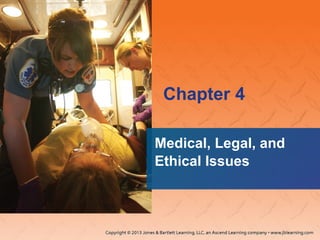- Paramedics must understand and follow medical ethics and laws to avoid civil and criminal liability. They are bound by professional ethics to do no harm, act in good faith, and act in the patient's best interest. EMS research presents ethical issues regarding informed consent.
- The legal system includes federal and state laws, with two types of law - civil and criminal. Lawsuits against paramedics usually involve negligence claims. Paramedics are subject to their state's medical practice act and scope of practice. Patient privacy is protected by HIPAA.
- Paramedics must obtain consent, honor patient refusals and autonomy when possible, and understand decision-making capacity, especially for minors. They must

















































































